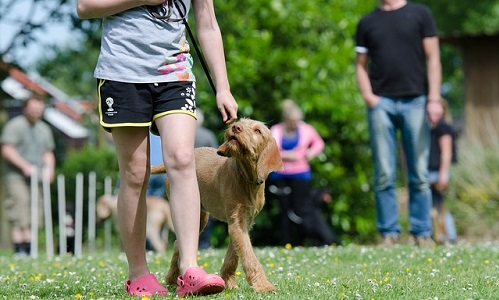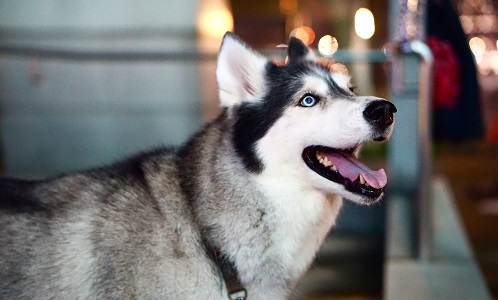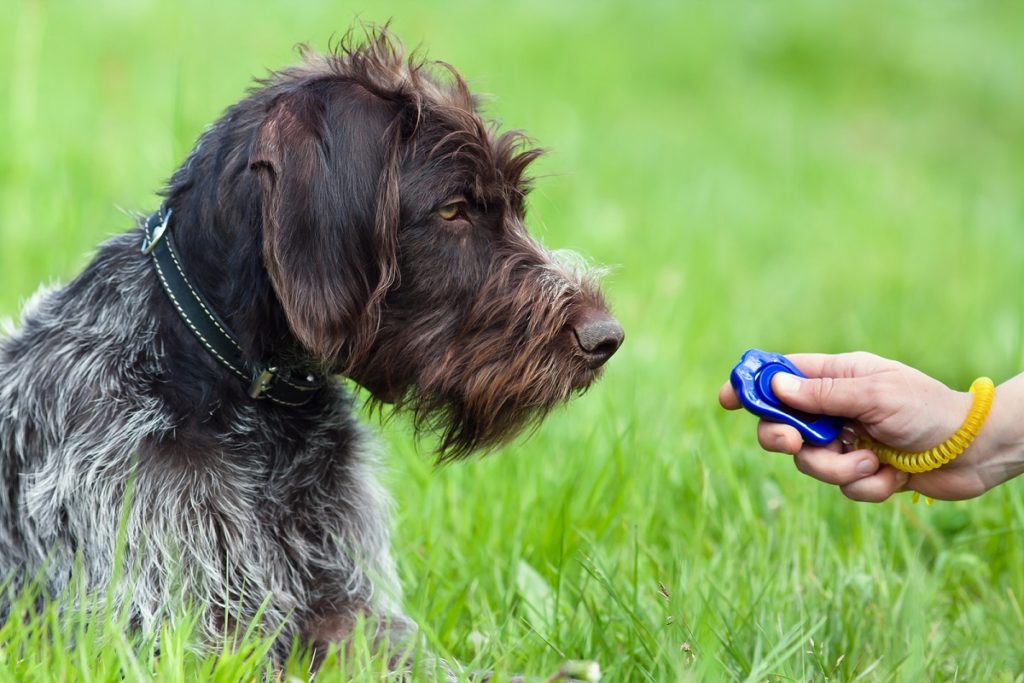Everyone has an opinion when it comes to dog training, but there’s one training method that’s actually based on science — using a dog clicker.
If you have a dog or are considering getting one, you may already have heard of clicker training, but might think it’s a bit hokey or too much work. However, neither are true! Dog clicker training can be quite easy for both trainer and trainee to master, and can be a much more rewarding experience for you and your dog, as well as an effective training method to follow.
In this post, we’re going to tell you all about how to train a dog with a clicker, with proven strategies that can help you and your dog form a closer bond, while also gaining a more obedient pet. And the best part is that this relationship will be created entirely through positive reinforcement and treats, so your pup will be eager to learn and you will enjoy training sessions that much more. Ready to uncover the clicker training method? Let’s get started.
What is Dog Clicker Training?
Clicker training is a science-based method of communicating with your dog. You can actually clicker train any animal, but dogs respond especially well to it because it is easier for them to master than standard command-based training. Clickers can be used to train puppies and adult or senior dogs as well.
Quite literally, clicker training involves the use of a toy noisemaker or clicker. You will use the clicker to “mark” any time your dog performs a wanted behavior. For example, if your dog sits on command, you will use the clicker when your dog sits and reward him with a treat. In this way, your clicker becomes a “conditioned reinforcer” because it is repeatedly paired with praise and treats — the two things your dog wants the most.
Through consistent training sessions, your dog will pick up on the training and learn that hearing the clicker means that he has done something right, and will be rewarded for his good work. This is actually rooted in behavioral science, which tells us that rewarded behaviors will continue.
How Did Dog Clicker Training Emerge & Become Popular?
 Clicker training actually originated with marine biologists. When studying and training marine mammals, marine biologists had to find a way to train them with positive reinforcement, as these animals could easily swim away if they didn’t like the trainer’s negative behavior. Marine biologists started using whistles with their training, which evolved to clickers with dogs.
Clicker training actually originated with marine biologists. When studying and training marine mammals, marine biologists had to find a way to train them with positive reinforcement, as these animals could easily swim away if they didn’t like the trainer’s negative behavior. Marine biologists started using whistles with their training, which evolved to clickers with dogs.
Clicker training has since been used to train hundreds of different species, including horses, cats, fish, hermit crabs, chickens, tigers, elephants, rabbits, rats, and more. Long ago seen as just a fad, clicker training gained popularity in the work of trainers B.F. Skinner, Marion Breland Bailey, Keller Breland, and Bob Bailey.
Why is the Clicker Method Better Than Command-only Training?
Clicker training is more effective because it marks the exact action you want your dog to perform. Using a clicker allows you to effectively communicate with your dog that his positive behavior will earn a reward. Here’s a quick example.
Let’s say you are teaching your dog to lay down. Often in training, dogs will pop back up to a stand almost immediately after their elbows hit the floor. While they did technically perform the desired behavior, the problem here is that you won’t be able to reward them fast enough for your dog to be able to connect the reward with lying down.
However, with a clicker, you can mark the behavior the moment your dog’s elbows hit the floor. Even if your dog does stand back up, you can still give the reward, and the dog will be able to learn what he is being rewarded for more easily. Over time, you can start to delay the click, so that your dog will learn that remaining down is what earns the reward.
As for how to train a dog using a clicker, there are several different tactics you can use, but they will all involve the same basic routine. Without issuing a cue or command, you want your dog to perform the desired behavior and you click the clicker to mark the exact moment your dog does what you want him to do (i.e. sit, lay down, speak).
Let’s dig into some of the strategies used in training a dog with a clicker.
“Charge” Your Clicker
You can’t actually dive right into training sessions right away using the clicker, or at least you shouldn’t. Why? Because your dog has no idea what the click means yet.
To get them familiar with the clicker and clicking sound, you’ll want to grab some tasty, healthy treats, and simply press the clicker button, then reward your dog with a treat. Then repeat — click and treat, click and treat, up to as many as 10 to 15 times. You can do this a few times the first day alone.
Then the next day, click your clicker and see if your dog reacts to the sound. If your dog comes toward you, alert, ears perked and looking for a treat, then you know they have already associated the clicker sound with being rewarded with a treat. If not, repeat the process from day one until they do.
Click During the Behavior, Not After
When training a dog with a clicker, you need to make sure you are using the clicker correctly. This means you are clicking during the action, rather than after it is completed. The timing of your click is incredibly important because it signals the exact moment your dog has done something right.
If your dog stops the behavior the second they hear the click, that’s okay! The click signals the end of the behavior, so as long as they are in the correct position or doing what you want them to do when you hit the click button, it will reinforce the behavior.
You Must Always Follow a Click with a Treat
You should always immediately reward your dog for a click with a treat. Even if you accidentally hit the clicker or clicked on a behavior that you don’t want to reinforce, you should still give your dog a treat. You have to remember that the click itself means nothing to your dog, but is motivated by the treats.
If you don’t follow a click with a treat, it will weaken the dog’s association with the clicker as a predictor of treats. If the clicker becomes unreliable, your dog will start to care less about it. Dogs thrive in reliable environments, and they may grow tired of training altogether if you aren’t consistent.
Start Simple
It’s best to start your dog’s clicker training with a simple behavior that he already knows and has mastered. For instance, you can use “sit” to begin your training, and click right when his bottom hits the floor. Then, you give your dog a treat.
You also shouldn’t add a cue until your dog starts to consistently perform the behavior. A steady rhythm of behavior — click — treat should be performed before your dog is ready to add in a cue. Eventually, your dog will offer to sit again right after you have given him a treat.
This is when you can start to add in a cue or command. Say “sit” right as your dog begins to lower their butt toward the ground, and click when they sit. You can then toss the treat away from the dog so they have to go get it, then get them to return and get ready for another sit. Then cue — behavior — click — treat — repeat, and on and on you go.
Once your dog associates the word with the behavior, you can test the command in different settings and environments, and even from further away.
Keep Your Training Sessions Short
Your dog, especially if you are training a puppy, will be much more eager to learn if your sessions are short rather than long. You can help keep your dog from growing bored with training by limiting your training sessions to just a few minutes at a time, a few times a day, instead of one hour-long session each day.
You should also build your training sessions into your normal routine. Dogs are very routine-based animals, and while there is nothing wrong with attempting a training session at any given time when you have a few minutes to spare, your dog will respond more eagerly when they begin to incorporate training into their own schedule.
Click for Good Behavior, Whether During Training or Not
 You can use your clicker for more than specific training sessions. Carry your clicker around and have it ready for any voluntary, or even accidental good behaviors that you want the dog to perform. You can coax your dog into desired movements or positions but never push or hold them. They need to learn how to do the behavior on their own.
You can use your clicker for more than specific training sessions. Carry your clicker around and have it ready for any voluntary, or even accidental good behaviors that you want the dog to perform. You can coax your dog into desired movements or positions but never push or hold them. They need to learn how to do the behavior on their own.
You can also click any time your dog goes to the bathroom in the proper area or refrains from jumping up on a visitor. You can also click to reward your dog for silence, or when your dog allows for slack in the leash line. Any good behavior your dog does that you’re able to catch in time — feel free to click! This can help eliminate bad behavior by reinforcing good behavior.
Do Not Increase the Number of Clicks
Clicking more than once does nothing to reinforce the behavior for the dog. In fact, it might even confuse them. If you want to show enthusiasm, give them extra treats, not extra clicks. Use a single click every time.
Click in Increments
No, this doesn’t conflict with the tip above. This refers to your dog’s behavior.
You don’t need to wait until the dog nails a behavior perfectly. You can click and treat for progress in the right direction, and continue to raise the goal as your dog learns. You can start by asking for more from your dog to earn their reward.
For instance, make them sit or lay down for long, or come toward you a little further. This is how you shape your dog’s behavior. You can also start adding in a cue or hand signal once they start doing the behavior on their own.
Stay Positive & Have Fun
The key to training a dog with a clicker, or any dog training really, is positive reinforcement. If you are ordering the dog around with commands — you’re doing clicker training wrong. Click training is not command-based in nature, commands or cues are something you can add in later.
Your dog isn’t disobeying you if he doesn’t respond to a command, he just hasn’t learned what it means yet. This is when it can be helpful to find more ways to cue and click for the desired behavior. Find a less distracting place to do your training sessions, or separate them from other family members or animals.
If you ever get frustrated during training, put the clicker away so you don’t associate your negativity with the clicker. Your dog will lose confidence in the clicker, and perhaps even you. Clicker training should be a fun way to increase your bond and encourage your dog to be an eager learner.




